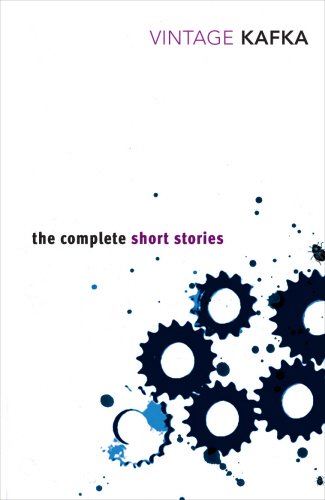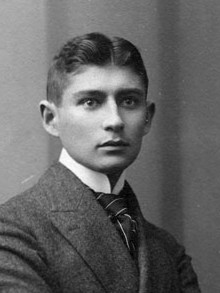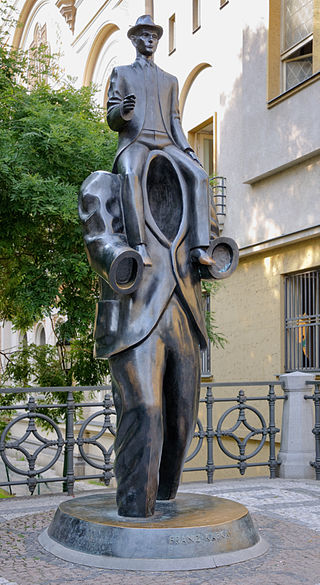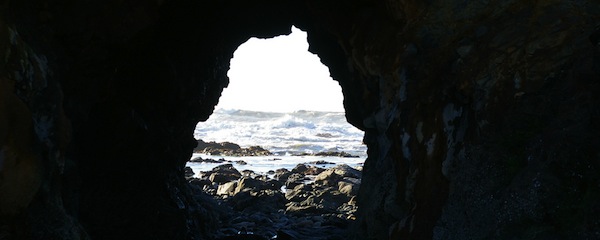
photo © Vladimir Agafonkin, 2014
by Gina Challen
A friend recently described an anthology of short stories as ‘bleak’. “Where”, she asked, “was there any humour?”
“You’ll find some writing in here to make you laugh,” I said, handing her, The Complete Short Stories of Franz Kafka, a hefty collection of his short work. There is a wealth of humour in Kafka; it all depends on how you read him.
Certainly, I am not implying that the tales are an easy read, there is nothing comfortable, or comforting, in Kafka’s work. In fact, much of his writing has the impact of a bucket of cold water over the head: shock – shocked laughter – and, when the story is over, a feeling of relief that you have survived. With this in mind, perhaps the stories should come with a reader warning across the front: Not for the faint hearted. But, a lot of the pieces are funny. Some are comic. And some are laugh-out-loud hilarious.
When discussing his work, it is worth remembering that Kafka was just an ordinary person with an ordinary life. Born in Prague in 1883, he studied law at university and went on to work for an insurance company, writing his sketches and  stories in his spare time. His diaries and letters show him as angst-ridden and full of self-doubt – writing to his publisher he commented, ‘that our epoch, and my time in particular, are very painful’. This is evident in his fiction: troubled times leading to troubled writing.
stories in his spare time. His diaries and letters show him as angst-ridden and full of self-doubt – writing to his publisher he commented, ‘that our epoch, and my time in particular, are very painful’. This is evident in his fiction: troubled times leading to troubled writing.
To write with humour is tough. To write with humour and succeed is very tough; it takes courage. After all, if the joke falls flat then the story dies. This is brave writing and, like all good comedy, it serves as a defence against both the pain of the outside world and the pain we heap on ourselves.
Kafka is an expert at blurring the boundary between normal and abnormal, leading us through strangely familiar landscapes created from a bewildering mix of the ordinary and the incredible. For me, this other worldliness is ‘Kafkaesque’. Then there are the barrage of other adjectives that are so often coupled with his work: dark, surreal, difficult, desolate and unfathomable are just a few that spring to mind. On the whole, I agree with all of these, but I am adding another description to the list: funny.
Many of his tales are full of a dark gallows humour, a black comedy that his friend Felix Weltsch called ‘gallows humour spiked with desperation, but liberating for them both’. Kafka forces us not only to gasp at the grotesque, but at the same time to laugh at the absurdity of the life that it underlines. On one level, the stories are simple, but in his hands the telling of them becomes complex and full of clever contradictions. ‘In the Penal Colony’ sees an officer recount, to a visiting explorer, the workings of a machine called the ‘Harrow’, onto which he will strap a condemned prisoner for a hideous and barbaric death. That the outcome will be monstrous cannot be doubted, but it is how the tale unfolds towards this outcome that is funny.
Kafka sets up a situation comedy where things go hopelessly wrong and the characters take their chances and bumble through it. The story is farcical, yet its tone is chillingly deadpan. Mundane accounts of the changing administration of the penal colony interweave the minutely detailed workings of a fantastical and outrageously complicated instrument, whose ‘one drawback is that it gets so messy’. We learn too of the difficulties of maintaining such a machine:
“…one of he cogwheels in the Designer is badly worn; it creaks a lot when it’s working; you can hardly hear yourself speak; spare parts, unfortunately, are difficult to get here.”
The delivery is so straight-faced that with an enviable sleight of hand Kafka tricks us into overlooking the horror, and instead we find ourselves smiling and empathising with the troubled officer.
“…and if I send for a new strap they ask for the broken old strap as evidence, and the new strap takes ten days to appear and then is of shoddy material and not much good. But how I am supposed to work the machine without a strap, that’s something nobody bothers about.”
And it does not matter that the officer, with his ‘two fine ladies’ handkerchiefs tucked under the collar of his uniform’, is a spectacular example of overstated pomposity. Or that the soldier and the prisoner, without understanding the French  speaking officer, somehow manage to parody the action with a nightmarish mime. Character-wise, no one is trustworthy, and all are funny, even the ineffectual explorer, who thinks, ‘It’s always a ticklish matter to intervene decisively in other people’s affairs’. Of course, the story deals with serious issues, and I am not denying the complexity of the metaphor, the breaking down of the old order and the dawn of a new era, but I am drawing attention to the many layers of finely written humour.
speaking officer, somehow manage to parody the action with a nightmarish mime. Character-wise, no one is trustworthy, and all are funny, even the ineffectual explorer, who thinks, ‘It’s always a ticklish matter to intervene decisively in other people’s affairs’. Of course, the story deals with serious issues, and I am not denying the complexity of the metaphor, the breaking down of the old order and the dawn of a new era, but I am drawing attention to the many layers of finely written humour.
Kafka is known for creating these untrustworthy, marginalised characters, both human and animal, who suffer painful isolation whilst they battle relentlessly against an unforgiving and dogmatic authority. That we can clearly see many of their struggles are invented, or, at least misplaced, plays a significant part in the hilarity. When Gregor Samosa, in ‘The Metamorphosis’, wakes to find he has transformed into an insect, one of his most pressing problems is not how to change back, but how he will get to work on time:
The next train went at seven o’clock; to catch that he would need to hurry like mad and his samples weren’t even packed up, and he himself wasn’t feeling particularly fresh and active. And even if he did catch the train he wouldn’t avoid a row with the chief, since the firm’s porter would have been waiting for the five o’clock train and would have long since reported his failure to turn up.
It is Gregor’s mute stupidity and delayed response to his situation that is comic. Meanwhile, the other characters fall about in noisy confusion: his mother faints, his father cries and shouts in equal measure, and the maid takes on the persona of a pantomime dame. This is classic vaudeville. Kafka has a flair for keeping the reader off balance – we worry about what will happen to Gregor, yet cannot help laughing as he is crushed beneath the absurdity of his existence, very much the metaphorical ‘bug underfoot’. And many of the characters in Kafka’s stories do die; succumbing, like Gregor, to such horrible and pointless ends that there can be no doubt that Kafka enjoyed exaggerating the ridiculous.
However, not all the stories have such a strong, loud theatrical humour. ‘A Hunger Artist’ tells of a man who creates an art form out of ‘professional fasting’. Kafka serves him up like a great ascetic, ‘pallid in black tights, with his ribs sticking out so prominently’, sitting in his cage, ‘down among straw on the ground’. The joke is that the Artist starves to death, not because he wants to elevate his life’s work to a higher state but, as he explains with his last breath: ‘“because I couldn’t find the food I liked. If I had found it, believe me, I should have made no fuss and stuffed myself like you or anyone else.”’
Richie Robertson observes, in Kafka: A Very Short Introduction, that ‘pathos and comedy together point towards a subdued black humour. It is not so much what you see, but how you see it, that concerns Kafka’. There is something edgy about the humour in this story: it is poignant, both silly and sad. I should be moved, instead I am amused, and this leads to a very uneasy laughter.
At times, he writes with a gentle irony, and perhaps the raucous slapstick of such tales as ‘In The Penal Colony’ and ‘The Metamorphosis’ overshadows the subtle wit to be found in some of the lesser-known, and often shorter, stories. In these pieces, rather than pile the humour up like a stack of unsteady bricks ready to crash to the floor, Kafka gives us a short comic sketch with a single comedic thread. The humour is quieter, personal, like a joke between friends.
The great sea-god in ‘Poseidon’ is so inundated with paperwork that, despite the rumours ‘that he was constantly cruising through the waves with his trident’, he had, in fact, ‘hardly seen the oceans, save fleetingly during his hasty ascent to Olympus, and had never really sailed upon them’. In the story ‘The New Advocate’ we are introduced to the battle-charger-turned-lawyer, Dr Bucephalus, who, ‘[with] his flanks unhampered by the thighs of a rider, free and far from the clamor of battle, he reads and turns the pages of our ancient tomes’. If we ask how he can turn pages with his hooves, we strip the magic from the joke.
Nothing in Kafka is quite how we expect it to be; it is not only the characters that are unstable, so many of the narrators are full of contradictions, telling us one thing then showing us the opposite. He wrote in his diary, ‘This morning, for the first time in ages, the joy of imagining a knife twisted in my heart’. I understand this paradox – it sums up, for me, the appeal of his stories: I like looking for the twist of the knife. It does not matter how many layers of humour I have to peel back, he always makes me smile when I spot the joke. Kafka picked his words with great care, so no doubt the writing is richer in the original German, but, for me, the humour transcends any translation barriers.
His is a laughter that resounds through the decades. We do not leave these stories behind at the turn of the twentieth century, and in Kafka there is no looking back to a time gone past with misplaced sentimentality. Who, today, has not been frightened by a constantly changing world? How many of us have suffered at the hands of over-zealous bureaucracy? The humour in his writing is as relevant now as it has always been. He has such a keen eye for the ridiculous that I only wish I could read Kafka’s tale of ‘the unexpected item in the bagging area’.
~
 Gina Challen has a Masters in Creative Writing from the University of Chichester. She is passionate about short stories, enjoying their intensity and diversity. Her work appears in various anthologies and has been shortlisted for the 2015 Bristol Short Story Prize, the 2014 Bridport prize, The Willesden Herald Short Story prize 2013, the Cinnamon Press Short Story Award 2012 and 2013, The Fine Line Short Story Award and longlisted for The Fish Short Memoir Prize 2012. She has read at Shoreham Wordfest 2012 as part of Rattle Tales and her story appears in Rattle Tales 2.
Gina Challen has a Masters in Creative Writing from the University of Chichester. She is passionate about short stories, enjoying their intensity and diversity. Her work appears in various anthologies and has been shortlisted for the 2015 Bristol Short Story Prize, the 2014 Bridport prize, The Willesden Herald Short Story prize 2013, the Cinnamon Press Short Story Award 2012 and 2013, The Fine Line Short Story Award and longlisted for The Fish Short Memoir Prize 2012. She has read at Shoreham Wordfest 2012 as part of Rattle Tales and her story appears in Rattle Tales 2.


